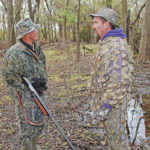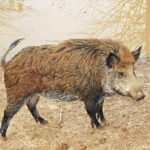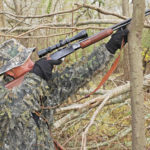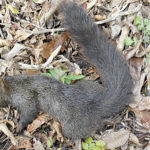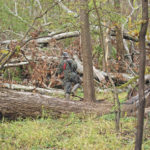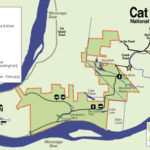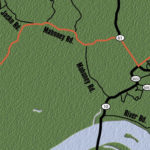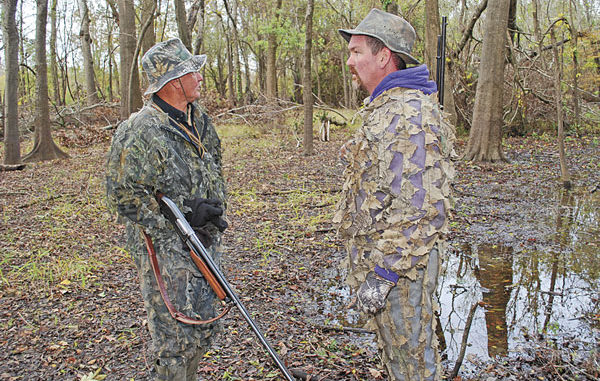
Ironically, it’s the fox squirrels — and not their smaller cousins — that draw hunters to Cat Island.
As Charles Johnson’s truck descended from the hills into the swamplands of West Feliciana Parish, its headlights swept through the giant trees. The sight washed a warm tidal wave of memories over me of our young manhood spent hunting squirrels and other small game in the swamp. Memories of boon hunting companions — Louie, Doughbelly, Nick and Uncle Shorty — memories of camping in giant hollow cypress trees, memories of axle-deep mud on logging roads, memories of big fox squirrels barking angrily at me on crisp mornings.
We passed in the darkness the last human habitation, the home of the swamp’s octogenarian legend, Moochie Metz, situated high on the elevated embankment of The Old Dummy Line, the bed of the railroad spur used to haul massive cypress logs from the swamp. The truck plunged deeper into the swamp, navigating what can best be described as an improved dirt road.
Our destination was the Cat Island National Wildlife Refuge.
With every turn in the road, the headlights panned through bigger trees, and the Mississippi River overflow swamp seemed to close in around us. My nose awakened to the memories of the swamp’s smells, the earthy odor of the rich alluvial soil, the cuttingly crisp sharpness of the winter air and the pungent skunkiness of a big boar black squirrel.
Our ride was different today, though. In the early 1960s, it was by Uncle Shorty’s Model A Ford or Johnson’s low-slung pink Plymouth convertible with a top that wouldn’t go up. Today, the shiny Chevy pick-up truck carried an ATV in its bed and another on a trailer behind it.
After checking in at the refuge check station, Johnson and his 39-year old son, Charles Jr., drove to the farthest parking lot on the refuge. As they unloaded their ATVs, the excitement of the two men was as palpable as if they were on an African big-game hunt. Instead, squirrels were their quarry, the humble creatures dismissed by deer-crazy hunters as “tree rats.”
But the 62-year old senior Johnson doesn’t “dis” the animals.
“They’re some of the gamest little critters in the woods. If you don’t think so,” he added, “go out in a place where they are heavily hunted and try to kill a limit.
“Their senses are so unbelievable that they amaze me even today. You can dress in complete camo and step into the woods, and they go to chattering. People ride around town and see squirrels, and think they’re easy to kill.
“Anyone can go out in the woods and kill a deer. I like to hunt turkeys too, but I still go back to squirrels.”
Hunting in several states, Johnson has killed, he estimates, nearly 500 deer. The thigh-high stack of antlers in his barn, plus numerous mounts on the walls, bear witness to his testimony.
With dawn approaching, the two men separated. The elder Johnson carried a .22 rifle, while Charles Jr. was armed with a shotgun. Johnson often hunts with a shotgun, but says the numerous wild hogs in Cat Island are much easier to kill with a rifle. He loves bringing home the bacon almost as much as he does squirrels, and if he can do both in one hunt, so much the better.
Before leaving sight of the ATV, he marked a waypoint on his hand-held GPS receiver, turned it off and stowed it in his pocket. Quietly, he eased down a game trail for a couple of hundred yards, stepped into the woods and disappearred in plain sight.
He seemed to be as invisible as The Predator in the 1987 Arnold Schwarzenegger movie by the same name. Only by watching closely could his form be discerned. He was actually tip-toeing through the woods, alternating between slow motion and freeze action.
His head was constantly but slowly scanning from side to side, and he periodically cocked it to turn an ear toward a suspicious sound. What he was looking for weren’t the forms of the squirrels themselves, but rather any motion that they made that didn’t fit into the routine movement of tree limbs in a breeze.
Sometimes the shaking limb was caused by a bird, but these he ignored. It doesn’t take long, Johnson said, for a hunter to learn how to distinguish between bird- and squirrel-caused movement. Squirrels’ movements are more deliberate than those caused by birds. Shaking limbs are easiest to spot, but Johnson advises to also watch for the quick flick of the creature’s tail. The important thing, he stressed, is for the hunter to see any and all movement.
It’s toughest to see movement when squirrels are feeding in dense clumps of poison ivy vines. Lazily laid up in the clumps, with lots of food within arm’s reach, these squirrels move very little. They are best spotted by watching for one of the pinpoints of light sparkling through the clump to disappear as the squirrel reaches for another poison ivy berry.
As much as Johnson uses his sight to locate squirrels, he maintains that he finds many more with his sense of hearing.
“Squirrels are actually pretty noisy animals, if you know what to listen for,” he said.
Most obvious are the various chatterings and barks that both fox and grey squirrels emit.
These vocalizations can be made for a variety of reasons. Often it seems the squirrels are simply communicating with each other; sometimes they are made in alarm, and other times the squirrels bark in inquisitiveness about a strange sound or sight they don’t understand.
What a hunter doesn’t want to hear is the low, slow clucking that a thoroughly alarmed (and well-hidden) fox squirrel makes. A similarly alarmed grey squirrel will make a slow mewing that sounds much like a housecat. From this alarm sound the creature receives its nickname, “cat squirrel.”
Most exciting for a seasoned squirrel hunter are the sounds of rutting squirrels. Male squirrels with reproduction on their minds, like deer and, for that matter, humans, lose all fear and wariness. As many as 15 males will determinedly chase a single female in season. In the ritual, the females utter squeals that sound very much like the woody squeak of a tree swaying in the wind. The males constantly and excitedly cluck. The peak of rutting activity for both fox and grey squirrels occurs in December.
Other sounds that alert Johnson to squirrel activity include the swish of moving leafy tree branches, the sound of claws on bark, the sound of nut fragments, called “cuttings,” dropping to the forest floor and sometimes even the sounds of a squirrel’s teeth chewing on hard mast such as hickory nuts or acorns.
As Johnson slowly moved through the woods, he periodically crouched to inspect cuttings of acorns and other tree fruits. Occasionally he used his secret weapon, a Mr. Squirrel Whistle, sold by Haydel Game Calls.
Johnson crouched, inserted the disc-shaped metal whistle in his mouth and while sucking on it, vigorously thrashed the ground with a leafy branch. The sounds, which imitate the wing beats of a hawk and the distress cry of a young squirrel, excite squirrels, causing them to bark loudly and run out to open tree limbs to get a peek at the action.
By mid-morning and with their limits not yet made, the two men rendezvoused in the woods briefly. Since the elder Johnson hadn’t seen any hogs, he exchanged the rifle with his son for the shotgun, and they separated. The hunt was on again. Unlike grey squirrels, fox squirrels will be active almost all day.
The Cat Island swamp’s trees are impressive — huge oaks and hackberries, scattered hickory trees, tupelo gums in the lower, wetter areas and by spots, outlandishly large cypress trees that give one a taste of what Louisiana’s forest primeval looked like in the days before logging.
Still moving like a ghost and never snapping a twig, the only sound Johnson made besides the occasional squirrel whistle was the report of his weapon when another squirrel bit the dust. After shooting a squirrel, he never moved immediately to pick it up. Often, he said, several squirrels will feed together in one spot. And indeed, later in the morning, almost without moving his feet, he killed three in one spot.
One of Johnson’s secrets seems to be that he pays more attention to hiding his own form than being able to see long distances. He invariably avoids the open park-like areas often found under stands of large trees. These are very attractive to novice hunters, but he says that in open woods, squirrels will spot a hunter long before the hunter spots them.
He prefers instead to move through woods that have a substantial understory of smaller trees or large shrubs beneath the tree canopy. He does however, avoid dense brush. But when he can’t avoid it, he doesn’t waste time trying to slither through it. He crashes it quickly, and then resumes his stealthy stalk when he emerges in huntable woods.
The hunt in the latter part of the morning took Johnson near numerous water-filled sloughs. There, following the dictates of Murphy’s Law, Johnson found huge areas of ground rooted up by hogs, and ultimately found the pigs themselves. But, equipped only with a shotgun and fine shot, he ignored them.
After the hunt and back at his ATV, Johnson talked about the Cat Island swamp while he munched on a moon pie and drank a Dr. Pepper.
“It tickled me to death when the feds ended up with the land for this refuge in 2000,” he said. “I hunted this for so many years as a young guy before it was closed off by hunting clubs.
“I love the scenery of the swamp, and this is the closest place for me to hunt fox squirrels.”
Johnson, who owns a tree farm between Woodville, Miss., and St. Francisville, has plenty of grey squirrels on his property, but still hunts Cat Island regularly.
“Cat squirrels taste better, but fox squirrels are bigger and prettier,” he said as he finished his snack. “They come in black and a bunch of different shades of red. I love the variety.”
Next month, learn what life was like for Charles Johnson growing up poor in the area, and truly living off the land.
